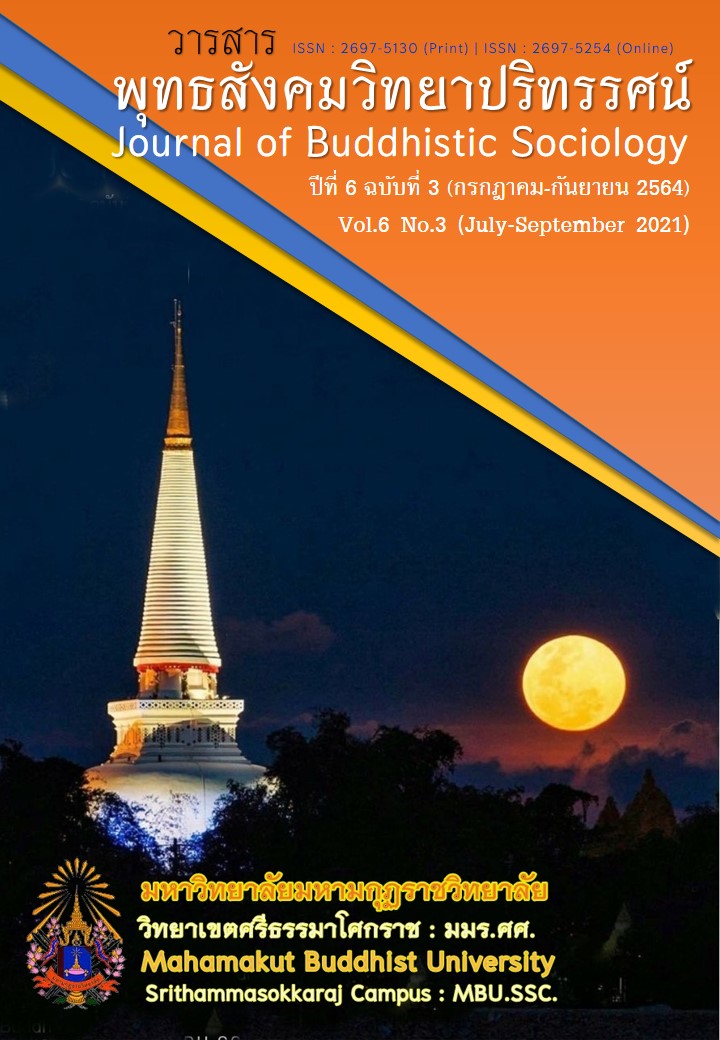TEACHING STRATEGIES FOR SOCIAL STUDIES IN THE CONTEXT OF THE DIGITAL ECONOMY
Main Article Content
Abstract
Teaching strategies for Social Studies in the context of the digital economy is learning and teaching management under the Buddhist way integrating the technology and modern information management. It is a strategy for teaching Social Studies to integrate the contents into learning subject groups. Learning integration is the way to use, choose, and develop learning innovation that promotes learner's learning and teachers' skills to lead to success or goals in the ever-changing social environment. The analysis of external factors aims to identify opportunities and limitations. The analysis of internal environment aims to identify weaknesses and strengths in organizing the learning process. These processes are to find appropriateness, feasibility, and regularity using flexibility under the environment that will truly result in the students' achievement. Teaching strategies for Social Studies must develop students to think critically, synthesize, distinguish, create new things, interact with teachers during class, develop their potential, be free to choose what they like, and be able to apply in the context of the current situation. Factors leading to the success of teaching and learning strategies for Social Studies include 1) the learning management for Social Studies subject groups is systematic, standardized, and single-direction process, 2) ability in using resources in the organization in a cost-effective manner with the highest efficiency for the learners, 3) Social Studies learning subject groups can join forces to share knowledge and 4) ability in bringing benefits from learning activities and media to use in teaching and learning management.
Article Details
References
กิ่งพร ทองใบ. (2545). แนวคิดของการจัดการเชิงกลยุทธ์. ใน เอกสารประกอบการสอนเชิงกลยุทธ์ การจัดการในภาครัฐเล่ม 1. นนทบุรี: มหาวิทยาลัยสุโขทัยธรรมาธิราช.
ชูชาติ เชิงฉลาด. (2546). การเรียนรู้แบบมีส่วนร่วม. กรุงเทพมหานคร: คณะครุศาสตร์ สถาบันราชภัฎธนบุรี.
ปั้นจั่น Meador. (ม.ป.ป.). สร้างอาร์เรย์ของกลยุทธ์การเรียนการสอนที่มีประสิทธิภาพ. เรียกใช้เมื่อ 30 มีนาคม 2563 จาก https://th.eferrit.com/สร้างอาร์เรย์ของกลยุทธ/
โยธิน มาศสุข. (2563). เอกสารประกอบการสอน รายวิชานวัตกรรมและเทคโนโลยีสารสนเทศทางการศึกษา. มหาวิทยาลัยมหามกุฏราชวิทยาลัย วิทยาเขตศรีธรรมาโศกราช.
วรางคณา ผลปนะเสริฐ. (2554). การจัดการเชิงกลยุทธ์ในการบริหารโรงพยาบาล . ใน เอกสารประกอบการสอน รายวิชา 58708 สาขาวิชาวิทยาศาสตร์สุขภาพ. นนทบุรี: มหาวิทยาลัยสุโขทัยธรรมาธิราช.
วัฒนา วงศ์เกียรติรัตน์. (2548). การวางแผนกลยุทธ์: ศิลปะการกำหนดแผนองค์กรสู่ความเป็นเลิศ. กรุงเทพมหานคร: สถาบันเพิ่มผลผลิตแห่งชาติ.
วิจารณ์ พานิช. (2560). เส้นทางสู่คุณภาพการศึกษายุคประเทศไทย 4.0. การประชุมเชิงวิชาการทางการศึกษาระดับชาติ ครั้งที่ 4 มหาวิทยาลัยวงษ์เชาวลิตกุล ศูนย์ประชุมสตาร์เวลล์. นครราชสีมา: มหาวิทยาลัยวงษ์ชวลิตกุล.
สมควร นามสีฐาน และพระประนม กุลภู. (2562). กลยุทธ์การสอนสังคมศึกษาตามแนวทางการจัดการเรียนรู้ตามแบบพุทธวิธี. วารสารวิชาการธรรมทรรศน์ มหาวิทยาลัยมหาจุฬาลงกรณราชวิทยาลัย, 19(4), 277-278.
สมชาย ภคภาสน์วิวัฒน์. (2544). การจัดการเชิงกลยุทธ์. (พิมพ์ครั้งที่ 5). กรุงเทพมหานคร: อมรินทร์.
สิริพัชร์ เจษฎาวิโรจน์. (2548). การจัดการเรียนการสอนแบบบูรณาการ. กรุงเทพมหานคร: บุ๊ค พอยท์.
อติพร เกิดเรือง. (2560). การส่งเสริมการเรียนรู้ในศตวรรษที่ 21 เพื่อรองรับสังคมไทยในยุค. วารสารมหาวิทยาลัยราชภัฏลำปาง, 6(1), 177-180.
อุทิศ ขาวเธียร. (2546). การวางแผนเชิงกลยุทธ์. กรุงเทพมหานคร: จุฬาลงกรณ์มหาวิทยาลัย.


